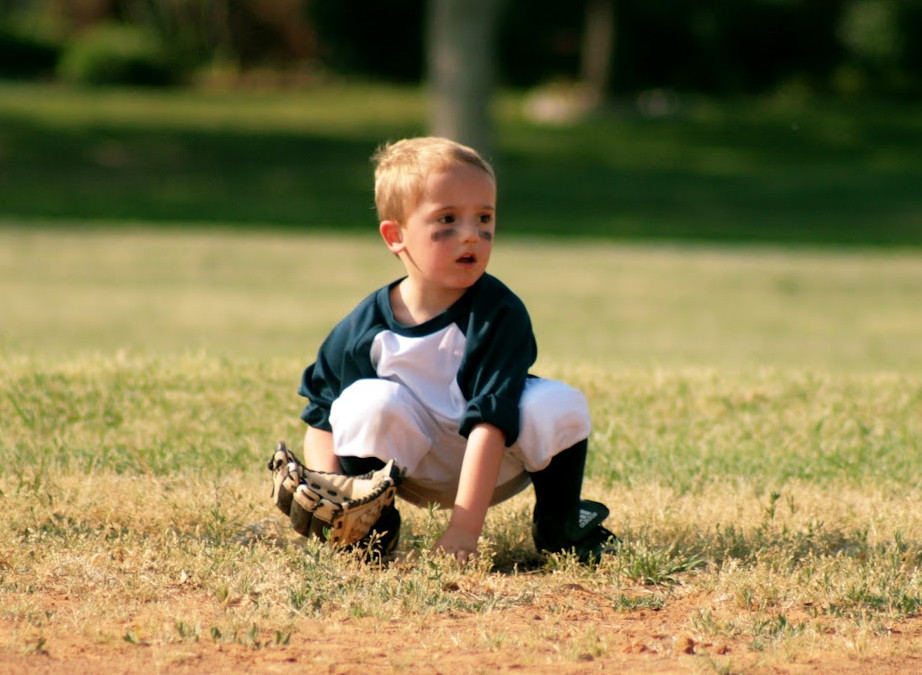Chasing butterflies, building dirt castles, and picking dandelions. Oh the memories!
Tee ball is awesome when you’re 5.
The phrase “youth tee-ball” could quite possibly be mentioned in the Webster’s definition of “frustration.” Parents taking hours out of their day to watch their childrens’ largely distracted, failed attempts at the skill sets of a sport so difficult that even at the professional ranks, a 30% success rate will get you into the hall of fame.
Before we go into the clichés of “no attention span” or “bad genetics,” let’s look at three more accurate reasons why youngsters, particularly under the age of 8, tend to struggle with the sport of baseball and tee ball.
 1. They can’t see!
1. They can’t see!
A child’s eyeball does not reach it’s normal, round shape until somewhere between their 6th and 9th birthday. While they can still track and follow moving objects, judging speed, distance, direction, and other spatial information is extremely difficult due to limited peripheral vision.
2. The roads aren’t in yet!
Generally, it’s not until about 6 years old that neural connections to major muscle groups are complete. Before that, the brain is able to coordinate movement, but in a very rudimentary, inefficient fashion. Even when major innervation is completed, connections to smaller muscles that control fine motor skill are still sparse.
It’s kind of like starting a new town and not having all the major streets laid that connect everyone to services. People could still tromp through the woods to get to where they needed to go. It would just take longer and they would get lost from time to time. Even when the major roads are created, it takes some time for individual streets leading to specific homes to be a priority.
Pairing low coordination ability to high coordination demand can be a formula for frustration.
3. No insulation!
As mentioned, by about age 6, neural innervation to major muscle groups is completed. The nerve fibers that create this connection, however, are immature. The brain transmits information to the muscles and vice-versa through electrical impulses that travel through neurons. Much like electric wiring, quality transmission of electricity requires the “wiring” to be insulated to quickly and efficiently propagate the current.
 Myelination is the process of nerve fibers becoming fully insulated to allow for faster, smoother, transmission of neural impulses. This doesn’t happen until about age 7 or 8. Prior to that, coordination patterns can be formed, however, it is difficult for them to be executed efficiently. Using the new town with roads metaphor, it would be like the town having the major nerve “roads” built, but the roads are made out of gravel and cobble until about age 8.
Myelination is the process of nerve fibers becoming fully insulated to allow for faster, smoother, transmission of neural impulses. This doesn’t happen until about age 7 or 8. Prior to that, coordination patterns can be formed, however, it is difficult for them to be executed efficiently. Using the new town with roads metaphor, it would be like the town having the major nerve “roads” built, but the roads are made out of gravel and cobble until about age 8.
Considering the smooth, carefully timed integration of hitting and throwing, one can see the possibility for frustration.
The antidote?
For one, take a deep mom or dad breath. It’s more nature than nurture on this one. While allowing kids a high volume of practice with the skills involved with baseball can aid in slightly accelerating certain developmental processes, maturation still has to take it’s course. Trying to outrun nature buys a ticket for fast frustration.
Secondly, if your child appears to be struggling to the point where they aren’t enjoying the sport, apply a little “object manipulation”. During practice or while at home, allow them to practice the baseball movements of hitting, catching, and throwing with implements that are easier to see, move slower, and allow a higher rate of success.
This allows the brain to practice the proper neural connections in order to progress to higher-level execution of the skills.
Meanwhile, butterflies will be chased, dirt castles will be built, and dandelions will be picked. Don’t forget to enjoy the process. It’s over too quickly!
Brett Klika CEO and co-founder of SPIDERfit is an international award- winning certified strength and conditioning coach, author, and motivational speaker with over 20 years experience motivating and inspiring youngsters to a life of health, fitness, and performance.
Brett consults with schools, athletic organizations, fitness professionals, and fortune 500 companies around the world.





Connect with SPIDERfit!